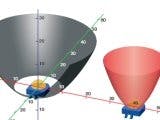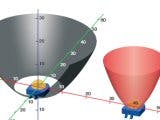Therefore, all LED applications can generally be divided into two groups: direct and indirect (see Fig. 1). The terms direct and indirect describe the relation between the LED and its secondary optic components, or the light target (the main optical axis). Also, the term direct (as for direct light/flux) is also used to emphasize the fact that LED applications use the flux from the primary optic lens of the emitter to create the light distribution.
Direct: A direct optical configuration is characterized by the alignment of the optical axis of the emitter(s) with the main optical axis of the light. This need not necessarily be coaxial. It can also be considered an issue of the direct visibility of the emitter (from a point of view within the desired angular emission range of the light). A descriptive example is a projector application using aspherical lenses for image creation. Such arrangements would be addressed as direct type, but they strongly restrict the visibility angles of the emitter, which is observed only through secondary optics.
Indirect: In contrast to the direct configuration, an indirect optical configuration will always prevent the emitter from being observed directly. Instead, the flow of light will be controlled completely by secondary optics, such as free-form reflectors. In the archetypical representation of an indirect configuration, the optical axis of the emitter will be antiparallel to the optical axis of the light (the reflector); for example, a perfectly reverse orientation. Any semi-direct solutions are also possible.
++++++
This article was published in the Sept/Oct 2009 issue of LEDs Magazine. To read the full version of this article, please visit our magazine page, where you can download FREE electronic PDF versions of all issues of LEDs Magazine.
You can also request a print copy of LEDs Magazine (available by paid subscription) and sign up for our free weekly email newsletter.






